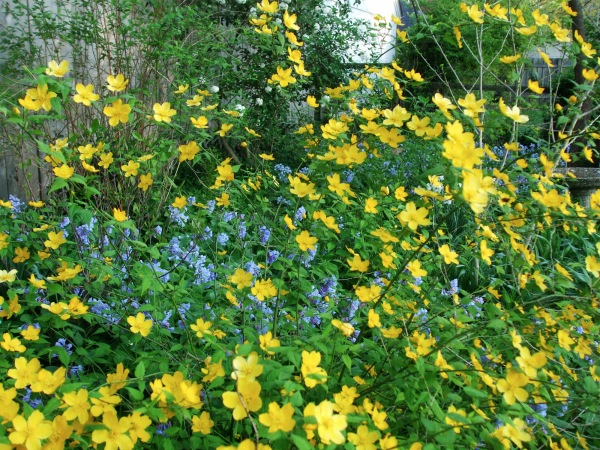
Native Virginia bluebell form a carpet of blue beneath the yellow Japanese Kerria. (C) Jo Ellen Meyers Sharp
If I could only have one perennial for certain situations, such as shade or sun…that’s what we talked about in last week’s column. This week, we’ll look at a few shrubs and trees.
First up is viburnum, a species that has a shrub for about any location. There are several native viburnums that are garden worthy, including arrowwood (V. dentatum) and the American cranberry bush (V. opulus var. americana), sometimes listed as V. trilobum).
But my favorite is burkwood viburnum (V. x burkwoodii), a large, semi-evergreen shrub with fragrant, pinkish-white, waxy flowers in April and respectable leaf color in fall. Although burkwood does best in full sun, mine has been in part sun for years and does just fine. It gets about 8 feet tall and 6 feet wide. The size and the fact that it holds onto its leaves well into winter, make it a good choice for a three-season screen. It is drought tolerant and attracts butterflies and birds. The latter likes the showy fruit, which is not messy.
For deep shade, consider a kerria, sometimes called Japanese yellow rose (K. japonica). My preference is the single flowering kerria, called ‘Simplex’, but there’s a double flowering yellow (‘Pleniflora’) and single white one, too (‘Alba’). In my yard, the kerria gets early morning sun and blooms the same time as my Virginia bluebells (Mertensia virginica) to make a beautiful spring scene.
Kerria does not do well in full sun, which bleaches out the flowers. Arched chartreuse branches brighten the winter landscape. At maturity, it will get 3-6 feet tall and wide, suckering a bit to develop a colony. The suckers can be removed to keep kerria the right size for your space. It tolerates clay soil, dry and wet sites and deer. The flowers are about the size of a quarter and it’s not uncommon for kerria to rebloom in late summer. ‘Golden Guinea’ is slightly smaller than the species.
For a shade tree, I select a thornless honey locust (Gleditsia triacanthos var. inermis) for lots of reasons. The native tree provides dappled shade, which allows grass to grow underneath. The small ferny leaves also blow away in fall, reducing raking duties. This tree can become a problem if the roots are cut or removed, which can promote the growth of sprouts. There are several honeylocust cultivars available. At maturity, the tree will be 30 to 70 feet tall and wide.